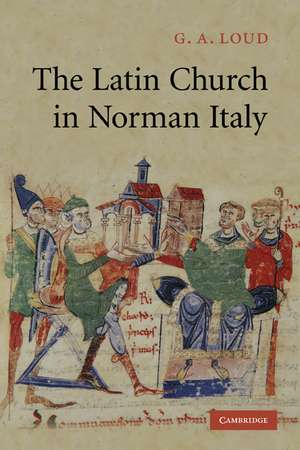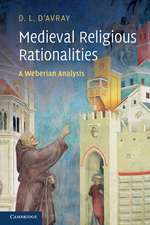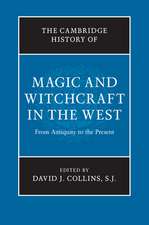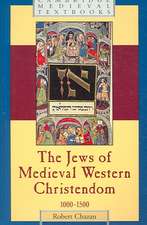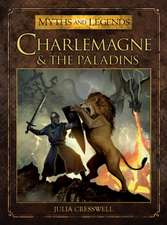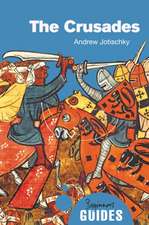The Latin Church in Norman Italy
Autor G. A. Louden Limba Engleză Paperback – 16 feb 2011
| Toate formatele și edițiile | Preț | Express |
|---|---|---|
| Paperback (1) | 436.89 lei 6-8 săpt. | |
| Cambridge University Press – 16 feb 2011 | 436.89 lei 6-8 săpt. | |
| Hardback (1) | 906.26 lei 6-8 săpt. | |
| Cambridge University Press – 19 dec 2007 | 906.26 lei 6-8 săpt. |
Preț: 436.89 lei
Nou
Puncte Express: 655
Preț estimativ în valută:
83.61€ • 90.79$ • 70.23£
83.61€ • 90.79$ • 70.23£
Carte tipărită la comandă
Livrare economică 23 aprilie-07 mai
Preluare comenzi: 021 569.72.76
Specificații
ISBN-13: 9780521181488
ISBN-10: 0521181488
Pagini: 596
Dimensiuni: 152 x 229 x 34 mm
Greutate: 0.86 kg
Editura: Cambridge University Press
Colecția Cambridge University Press
Locul publicării:Cambridge, United Kingdom
ISBN-10: 0521181488
Pagini: 596
Dimensiuni: 152 x 229 x 34 mm
Greutate: 0.86 kg
Editura: Cambridge University Press
Colecția Cambridge University Press
Locul publicării:Cambridge, United Kingdom
Cuprins
Introduction; 1. The Church in southern Italy before the Normans; 2. The Church and the Norman conquest; 3. The papacy and the rulers of southern Italy; 4. The papacy and the Church in southern Italy; 5. The Kings of Sicily and the Church; 6. The Church and military obligation; 7. The secular Church; 8. Monasticism; 9. Latins, Greeks and non-Christians; Conclusion.
Recenzii
Review of the hardback: 'Being a fruit of many years of research, The Latin Church in Norman Italy is a true gem of scholarship by a distinguished scholar who has already published extensively on medieval southern Italy. It is a volume that packs in an enormous amount of original research and knowledge and is a great resource for both historians of medieval Italy and of the medieval Church and religion. … Overall, The Latin Church in Norman Italy is a marvellous read, written in consistently clear prose, full of interesting detail and anecdotes. The volume comes with an impressive bibliography featuring primary sources of the greatest variety, particularly rich in chronicles, six appendices, and a subject index. … this is a book that will deservedly be mined by scholars of diverse interests for many generations.' Church History
Review of the hardback: 'G. A. Loud has produced an extremely valuable contribution to the history of Norman Italy and Christianity in the high Middle Ages. It is an especially important book because it discusses a topic that has never before been given such a thorough and in-depth treatment. … It contains a wealth of information on the people and institutions that made up the Norman Church, reflecting Loud's intimate knowledge of the archives and sources. It also provides useful points of comparison between the Church in Norman Italy and other parts of Latin Christendom. It is a book that will be useful for scholars of Norman Italy as well as anyone interested in the history of the Church in the Middle Ages.' The Catholic Historical Review
Review of the hardback: 'This book's magisterial display of learning will make indispensable reading for all those interested in both the Norman kingdom and wider issues of continuity and change in the midst of the great transformative changes of eleventh- and twelfth-century Europe.' Journal of Ecclesiastical History
Review of the hardback: 'G. A. Loud has produced an extremely valuable contribution to the history of Norman Italy and Christianity in the high Middle Ages. It is an especially important book because it discusses a topic that has never before been given such a thorough and in-depth treatment. … It contains a wealth of information on the people and institutions that made up the Norman Church, reflecting Loud's intimate knowledge of the archives and sources. It also provides useful points of comparison between the Church in Norman Italy and other parts of Latin Christendom. It is a book that will be useful for scholars of Norman Italy as well as anyone interested in the history of the Church in the Middle Ages.' The Catholic Historical Review
Review of the hardback: 'This book's magisterial display of learning will make indispensable reading for all those interested in both the Norman kingdom and wider issues of continuity and change in the midst of the great transformative changes of eleventh- and twelfth-century Europe.' Journal of Ecclesiastical History
Descriere
This 2007 book examines the relationship between Norman rulers, south Italian churchmen and the new 'papal monarchy'.
